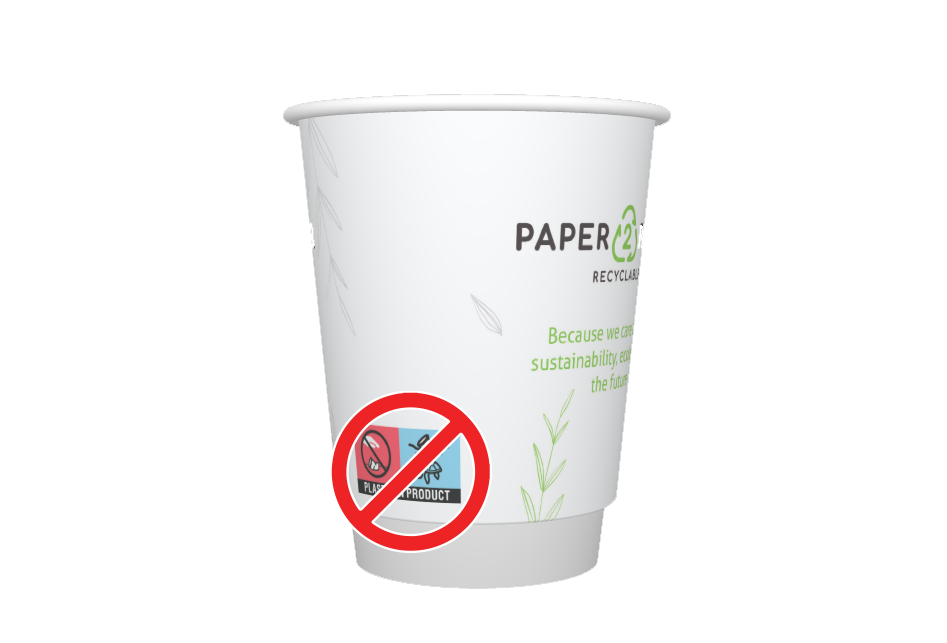Pradėti kurti dizainą
Rinktis produkto tipą ir dydį

Norėtume pasidalinti informacija apie reikalavimų, nurodytų Europos Parlamento ir Tarybos direktyvoje (ES) 2019/904 (2019 m. birželio 5 d.) dėl tam tikrų plastikinių gaminių poveikio aplinkai mažinimą, įgyvendinimą. Vienkartinio naudojimo plastiko direktyvoje (Single Use Plastic Directive - SUPD) nurodytos taisyklės turi būti taikomos vienai mūsų gaminamų produktų grupei - popieriniams puodeliams (puodeliai skirti gėrimams).
Išanalizavę SUP direktyvoje nurodytą informaciją ir iš žaliavų kartono gamintojų gautus argumentus bei gavę teisinių patarėjų rekomendacijas, teigiame, kad popieriniams puodeliams, kuriuos gaminame iš kartono su vandens pagrindo barjeru (Paper2Paper vienasieniai ir dvisieniai puodeliai) netaikomos SUPD nuostatos ir „GAMINYJE YRA PLASTIKO“ ženklinimas nėra reikalingas.
Norėtume pažymėti, kad aukščiau išdėstytos išvados daromos atsižvelgiant į SUP direktyvą, bet neatsižvelgiant ir nevertinant kiekvienos Europos Sąjungos šalies nacionalinių įstatymų.
Kol kas pavyko sužinoti tiek, kad vis dar nėra paskelbtų reglamentų, kaip SUPD bus įgyvendinamas nacionaliniu mastu. Taigi, yra rizika, kad kai kuriose Europos šalyse gali būti šiek tiek skirtingos SUPD interpretacijos ir skirtingas plastiko gaminių, kuriems taikomi SUPD reglamentai, apibrėžimas, todėl kiekvienoje Europos šalyje gali būti skirtingos produktų ženklinimo taisyklės. Prieš pateikiant popierinių puodelių gamybos užsakymus, rekomenduojame patikrinti šalies, kurioje dirbate, SUPD taisykles.
Atkreipkite dėmesį: Popieriniams puodeliams, pagamintiems iš kartono su PE arba PLA danga, SUPD taisyklės turi būti taikomos. Parengėme trumpą informaciją, kaip pažymėti popierinius puodelius pagal SUPD. Informaciją rasite čia.
|
Atsakomybės apribojimas: Šis laiškas buvo parengtas pagal informaciją, surinktą iš viešai prieinamų informacijos šaltinių, galiojančius įstatymų reglamentus ir iš žaliavų gamintojų gautus dokumentus. Šiame laiške pateikta nuomonė yra mūsų vertinimas ir teisinio reglamentavimo aiškinimas. |
Toliau rasite išsamesnę vieno iš kartono gamintojų informaciją apie kartoną su vandens pagrindo barjeru, jo ypatybes ir argumentus, kad šiame gaminyje nėra plastiko. Informaciją pateikta originalo (anglų) kalba.
Pabrėžiame, kad šiai informacijai, kurią gavome iš gamintojo, taikomas aukščiau nurodytas atsakomybės apribojimas. Mūsų gamintojo vardu mes dar kartą pabrėžiame, kad ši informacija negali būti naudojama viešai, ir jokia garantija, susijusi su šios informacijos tikslumu ar išsamumu, nėra išreikšta ar numanoma. Šis laiškas ar bet koks pridėtas dokumentas gali būti naudojami kaip pagrindas ar jais galima remtis priimant bet kokį jūsų sprendimą ar įsipareigojimą. Informacija ir jos aiškinimas laikas nuo laiko gali keistis. Mes gavome savo gamintojo komentarus dėl savo pačių vertinimo ir gamintojas neprisiima jokios atsakomybės už šios informacijos naudojimą.
SUP Directive defines in Article 3(1) [plastic definition]:
“‘plastic’ means a material consisting of a polymer as defined in point 5 of Article 3 of Regulation (EC) No 1907/2006, to which additives or other substances may have been added, and which can function as a main structural component of final products, with the exception of natural polymers that have not been chemically modified”
Mill-house position:
• Water-based dispersions (having pigments and latex binders as constituents) do not form a main structural component; they do not hold a shape and they require a substrate for a structure.
• Like standard pigment-coated carton boards, water-based dispersion barrier-boards are mono-materials, that are produced on-line in the board machine with the same integrated technology of standard pigmented boards.
• Water-based dispersions are non-separable from the substrate and are repulped to follow the fibers for secondary use in paper and board products
Based on the above definition, water-based dispersion barrier boards should not belong in the scope of the directive but should be excluded, equally to the standard paper and board.
Implementation guidelines
The European Commission published guidelines for the implementation of the SUP Directive on May 31 2021. The guidelines exclude paper- and board-based material in general from the scope of the SUP Directive:
“In particular, paper- and board-based products have in the preparation of the legislative proposal for the Directive specifically been assessed for their potential to serve as a sustainable alternative to single-use plastic products. Consequently, paper- and board-based single-use products made only from paper- and board-based material and without a plastic lining or coating are not, in light of the considerations above, to be considered as single-use plastic products in the meaning of the Directive.”
Further, the implementation guidelines state the use of such polymeric materials, e.g., as retention agents or binders and processing aids in the production of a material, which in itself is not plastic, does not result in the single-use product made only of that material to be considered as being made partly of plastic. The SUP Directive itself expressly excludes paints, inks and adhesives from its scope (Recital 11).
Implementation guidelines state:
“However, when a plastic coating or lining is applied to the surface of a paper- or board-based or other material to provide protection against water or fat, the final product is considered a composite product composed of more than one material of which one is plastic. In this case, the final product is seen as being made partly of plastic.”
The monomaterial status of water-based barrier boards’ as carton board (paperboard) has been established as noted above and it should, therefore, not be considered as a 'composite product composed of more than one material of which one is plastic'.
In conclusion:
• Water-based barrier boards should be considered as paper- and board-based materials, which are excluded from the scope of the SUP Directive.
• Constituent polymers of water-based barrier boards do not have the ability to function as a main structural component of final products. Constituent polymers are to be considered analogous to paints, inks and adhesives (notably, the water-based dispersions in cups and straws) or retention agents, binders and processing aids, which are exempted from the scope of the SUP Directive.
• Because of the monomaterial status of water-based barrier boards, they cannot be considered as a “composite product composed of more than one material of which one is plastic”. As water-based barrier boards cannot be seen as being made partly of plastic, they should not fall within the scope of the Directive.